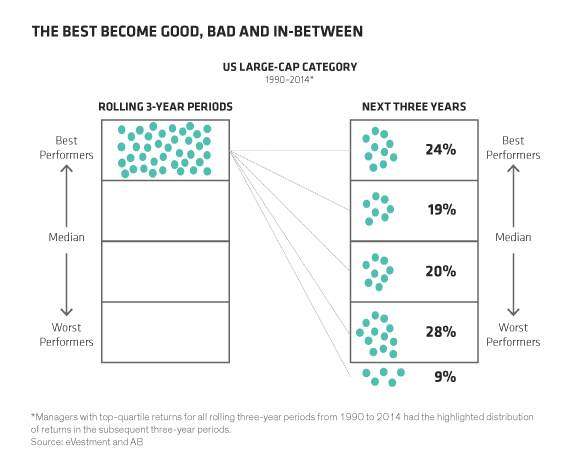Why “Best of Breed” Often Fails
by Equity Research, AllianceBernstein
Many investors seek “best of breed” managers across each category of stocks. The logic seems compelling: Diversify your risk across categories, while choosing the best performing funds using a framework such as Morningstar’s Style Box. Unfortunately, this approach tends to deliver poor outcomes.
We think that the “best of breed” selection process systematically leads investors to buy high and sell low—because somehow, the “best” funds in each category tend to be those with the best recent performance—and as many studies have shown, past performance does NOT guarantee future performance. Our own study found that the top-quartile managers for all three-year rolling periods between 1990 and 2014 had essentially random performance for the next three years (Display 1).

More insidiously, the “best of breed” selection process tends to lead to portfolios that in combination are both less active and less diversified than you’d expect.
Consider the results of a simulation that we performed recently. We combined four US large-cap funds that had received five-star ratings from Morningstar in the value, growth, core, and low volatility categories. Each manager was reasonably concentrated, which allowed each of them to do relatively well on a stand-alone basis.
But the combination of all four funds owned nearly half the stocks in the S&P 500, with an average position size of 0.3%, not much more than the 0.2% average index weight, As this example illustrates, a combination of “best of breed” managers can end up looking a lot like the index, with less active outperformance potential than investors expect.
Investing in Style Box winners also doesn’t provide the diversification desired, because at any one time, the best-performing managers in each category tend to share similar exposures to characteristics, such as above-average growth, income, quality, and momentum—or below-average valuations.
Over the long term, stocks that have one or more of these attractive characteristics tend to outperform the market, for good fundamental reasons. Over shorter time periods, however, they can underperform. Indeed, stocks with these characteristics have historically cycled in and out of leadership.
For example, stocks with high growth and high income did best in the three years ending August 2012 and stocks with high momentum and low valuations did worst, as the left side of the Display below shows. But in the next three years, stocks that offered high growth and income did worst. It was high momentum and attractively valued stocks that did best.

Imagine an investor seeking to diversify across growth and value categories in the summer of 2012 by picking the top-ranked funds in each style. At that time, the top growth funds emphasized high growth and income, but not momentum. The top value funds held “relative value” stocks with more growth and income than other value portfolios—and focused least on “deep value” stocks with low price-to-book ratios. In other words, the highest-rated funds in different style boxes were likely to share exposure to the growth and income factors that were performing well. And both did poorly in the subsequent three years, most likely, for that very reason.
The Style Box was a great breakthrough in its time. But we think there’s a better way to diversify—by combining individual stocks, rather than portfolios, with different stock-specific and factor exposures. More on that, later.
The views expressed herein do not constitute research, investment advice or trade recommendations and do not necessarily represent the views of all AB portfolio-management team,
Chief Investment Officer—Strategic Equities and US Value Equities

Joseph Gerard Paul serves as Chief Investment Officer for Strategic Equities, appointed in 2014, and US Value Equities, appointed in 2009. He has also served as CIO of the Advanced Value Fund since 1999. Paul was previously CIO of Small & Mid-Cap Value (2002–2008) and co-CIO of Real Estate Investments (2004–2008). Additionally, he was the director of research for the Advanced Value Fund for two years. In that role, Paul was instrumental in the genesis of the Advanced Value leveraged hedge fund. He joined Bernstein in 1987 as a research analyst covering the automotive industry, and was named to the Institutional
Investor All-America Research Team every year from 1991 through 1996. Before joining the firm, Paul worked at General Motors in marketing and product planning. He holds a BS from the University of Arizona and an MS from the Massachusetts Institute of Technology’s Sloan School of Management. Location: New York
Chief Investment Officer—Bernstein

Seth Masters is Chief Investment Officer of Bernstein. He heads the team that provides customized wealth-planning advice and manages the firm’s private client portfolios. Masters was previously CIO for Asset Allocation, overseeing the firm’s Dynamic Asset Allocation, Target Date, Target Risk and Indexed services. In June 2008, he was appointed head of AllianceBernstein’s newly formed Defined Contribution business unit, which has since become an industry leader in custom target-date and lifetime income portfolios. Masters became CIO of Blend Strategies in 2002 and launched a range of style-blended services. From 1994 to 2002, he was CIO of Emerging Markets Value Equities. He joined Bernstein in 1991 as a research analyst covering global financial firms. Masters has frequently been cited in print and appeared on television programs dealing with investment strategy. He has published numerous articles, including “The Case for the 20,000 Dow”; “Long-Horizon Investment Planning in Globally Integrated Capital Markets”; “Is There a Better Way to Rebalance?”; and “The Future of Defined Contribution Plans.” Masters worked as a senior associate at Booz, Allen & Hamilton from 1986 to 1990 and taught economics in China from 1983 to 1985. He holds an AB from Princeton University and an MPhil in economics from Oxford University. He is fluent in French and Mandarin Chinese. Location: New York
Related Posts
Copyright © AllianceBernstein















